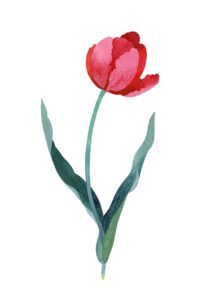 Reasserting Autonomy and Identity in Midcentury America
Reasserting Autonomy and Identity in Midcentury America
By Hannah Phelps (’23)
Sylvia Plath’s “Tulips,” published posthumously in 1965 as part of the Ariel collection, is one of her most widely analyzed works. According to literary scholar Carolyn S. Gonzalez (2019), the poem was written following Plath’s hospital stay for an appendectomy and possible miscarriage; thus causing a struggle between cultural expectations of motherhood and Plath’s desire to rebuke these standards and create her own sense of self.
Hence, tulips capture an intrinsic fight against the confines of 1950s gender roles and domesticity. In “Tulips,” Plath uses red tulips as a symbol to explore her role as a woman in midcentury America and reassert her autonomy in the face of these strained socio-political conditions.
Plath constantly grapples with the divide between family and career in her personal life and creative works. The Bell Jar, Plath’s most widely known work, articulates her frustration regarding her femininity and the limitations upon her sex. The novel’s leading character, Esther Greenwood, navigates life as a young, professional woman in 1950s New York City while battling mental illness and rampant sexism.
In The Bell Jar, Esther’s boyfriend, Buddy Willard, reiterates his mother’s philosophy on marriage: “What a man is is an arrow into the future and what a woman is is the place the arrow shoots off from” (Plath 2005: 72). Thus, women must merely support their husbands rather than chasing their own ambitions. This future did not appeal to Esther or Plath, who wanted to pursue motherhood and a successful writing career. Later in the novel, when considering her future marriage prospects, Esther notes “The last thing I wanted was infinite security and to be the place an arrow shoots off from” (Plath 2005: 83). In articulating this desire, Esther (and, probably also Plath) rejects the traditional expectations of womanhood as confined purely to marriage and childrearing.
This quest for autonomy and power over social circumstances can also be seen in Plath’s “Tulips,” particularly as the speaker rebukes traditional gender roles through color. Here, an understanding of tulip horticulture can shed light on the literary devices Plath uses in “Tulips.” One of the most compelling aspects of tulips is their range of colors, which come in white, red, yellow, brown, black, purple, and every imaginable combination of these. There are almost 4,000 horticultural varieties of tulips, developed from breeder-initiated hybridization (Shekhdar 2022). This centuries-long effort to produce the broad array of tulip colorations we have today represents an effort to control nature and create beauty.
This diversity is crucial to consider from a literary point of view, particularly for understanding why Plath may have chosen to make the flowers in her poem red. This vibrant color, typically associated with anger, is pivotal within “Tulips.”
Plath describes the white walls of the hospital room where the poem takes place, noting “Look how white everything is, how quiet, how snowed-in. / I am learning peacefulness, lying by myself quietly / As the light lies on these white walls, this bed, these / hands.” This sense of peace and calm is disrupted by the presence of the tulips, as Plath claims: “The tulips are too red in the first place, they hurt me” (Plath 2018: 19).
In “Tulips,” the plants present a reminder of domestic life, family, and marriage. As the speaker looks around the hospital room and notices the tulips, her eyes are caught by family photos of her child and husband. She claims, “My husband and child smiling out of the family photo; / Their smiles catch onto my skin, little smiling hooks” (Plath 2018: 18). The speaker’s temporary refuge from the domestic sphere via the hospital room is infiltrated by the tulips— a personification of her wifely and motherly duties.
Ultimately, Plath’s use of color and rejection of gender roles culminate in her attempts to challenge her feminine identity. The tulips are emblematic of this struggle due to their connections to Plath’s domestic life. The presence of the flowers denies her autonomy. They remind her of her obligations outside the hospital room, so she is unable to achieve the escape she craves. “Tulips” reflects broader social attitudes and writings on feminist identities of midcentury America and is in line with Plath’s quest for autonomy within her previous works, such as The Bell Jar.
Autonomy is, for Plath, a site of constant tension and re-negotiation. Throughout her personal life and creative works, she attempted to determine how (and if) two parts of her identity can co-exist: the future mother and author. Perhaps “Tulips” can be seen as the culmination of this internal debate. Analyzing “Tulips” through this feminist and botanical lens furthers our sense of Plath as a writer, woman, and feminist theorist who sought to move beyond common narratives on womanhood.
Works Cited
Gonzalez, Carolyn S. 2019. “The Perfectly Unadjusted Woman: Reading Adaptation in ‘Tulips’ and ‘The Yellow Wallpaper.’” Humanities Bulletin 2 (2): 175–84.
Plath, Sylvia. 2005. The Bell Jar. 1st edition. Princeton, NJ: Harper Perennial Modern Classics.
———. 2018. Ariel: The Restored Edition: A Facsimile of Plath’s Manuscript, Reinstating Her Original Selection and Arrangement. Reprint edition. New York, NY: Harper Perennial Modern Classics.